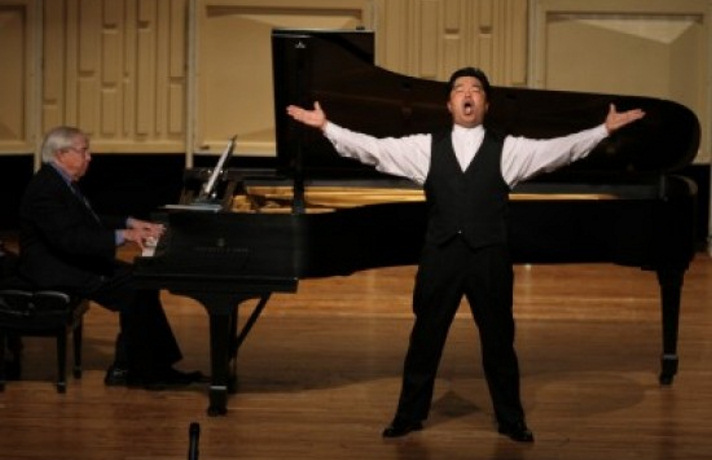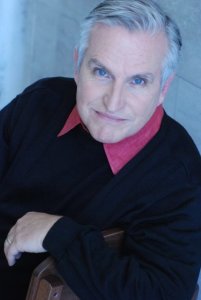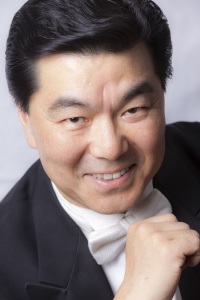Christopheren Nomura, at age 51, is perhaps the preeminent baritone singer of his generation. The Japanese-American prodigy was raised in the San Francisco Bay area and began his singing career early as a boy soprano. He made his professional operatic debut in the boys’ choir of the San Francisco Opera at age 6 and performed his first solo role at age 11 in Die Zauberflöte. He was the 1992 Young Concert Artists International Auditions winner and the recipient of the Paul A. Fish Memorial Prize. He’s been the recipient of many other awards and prizes including First Place winner in the International Vocal Competition Mozarteum in Salzburg, Austria, and in the Naumburg, the United States Information Agency Music Ambassadors and the Marilyn Horne Foundation competitions. Notable among his many distinctions was a Fulbright Grant, extended to four years, to study voice with renowned late 20th century baritone legends Dietrich Fischer-Dieskau, Hermann Prey and Gérard Souzay in Germany and France.
Since beginning his professional career in 1988, the baritone has earned a prominent place on the operatic, concert and recital stages, appearing with many of the leading North American orchestras, in wide-ranging repertoire: the Boston Symphony, Philadelphia Orchestra, San Francisco Symphony, Minnesota Orchestra, Saint Paul Chamber Orchestra, National Symphony Orchestra, Orchestra of St. Luke’s, Baltimore Symphony Orchestra, Vancouver Symphony, Indianapolis Symphony, Charlotte Symphony, Utah Symphony Orchestra, Philharmonia Baroque Orchestra and the Boston Pops under internationally renowned conductors such as Leonard Bernstein, Seiji Ozawa, James Conlon, Sergiu Comissiona, Christof Perick, Roger Norrington, Christopher Hogwood, Ton Koopman, Bruno Weil, Paul Goodman, Jane Glover, Andrew Parrott, and Nicholas McGegan. Known for his deep commitment to the art of the recital, he has given more than 250 recitals throughout North America, Europe, Asia, South America and Africa. He has appeared at Lincoln Center, the “Making Music” series at Carnegie Hall, the Celebrity Series in Boston, Ravinia, the John F. Kennedy Center and the Vancouver Recital Society. Among other notable performances, he was invited to sing Bernstein’s Mass at the Vatican for the “Jubilee Year,” in 2000 performing before an audience of 15,000 in the Salla Nervi, simulcast to some 200,000 people in Vatican Square.
He has also recorded extensively, including recordings on the Sony, Dorian, Teldec, London, Denon, TDK and L’oiseau Lyre labels. His recording of the Monteverdi Vespers of 1610 on Telarc was nominated for a Grammy (Best Classical Ensemble Recording). He recorded Schubert’s Die Schöne Müllerin for Well-Tempered Productions and Never Broken a solo recording of contemporary compositions, for Center Stage Records. All Is Bright with Grant Llewellyn and the Handel and Haydn Society made the Billboard classical charts and was named Musicweb International’s “Recording of the Month.”
He has sung to praise and plaudits time after time, without exception, with reviewers falling all over themselves (you can add me to the list) trying to find original and suitable words to convey what a singular, surpassing talent Mr. Nomura presents, in recital, in concert, in operatic performances, in song.
Chamber Music Concerts (CMC) brought Mr. Nomura, seemingly in the midst of an incomparable career and definitely at the top of his form, to the stage of the Southern Oregon University Music Recital Hall in Ashland on Friday evening, April 24 for an Explorations vocal recital, the last recital and ONLY vocal recital of the CMC season. Mr. Nomura was joined by non-pareil piano accompanist, Daniel Lockert, another prodigy, who began piano studies at the age of five in San Diego. Mr.Lockert received degrees in Piano Performance from Loma Linda University and an advanced degree in piano accompaniment from the University of Southern California, and was the only American finalist in the first International Accompanying Competition held in the Netherlands. He has had an active career accompanying choral groups, singers and instrumentalists throughout the United States, Europe, Japan, Australia and New Zealand, and has been on the staffs and faculties of the Juilliard School, the San Francisco Opera, Opera San Jose, the San Francisco Conservatory of Music, Chapman University and the Aspen Music Festival.
The program presented by Mr. Nomura consisted of music specially selected by him “as music that holds much meaning for me”, with a unifying central theme of “The Wanderer’s Night”, which pretty much defines his adult life as a constantly touring, wandering singer. He began the program with a series of seven songs from Franz Schubert’s Die Schöne Müllerin, based on poems by Wilhelm Müller. It is a widely performed and recorded (including by Mr. Nomura) work, considered one of Shubert’s most important cycles. The songs move from cheerful optimism to despair and tragedy. At the beginning, a young journeyman miller wanders happily through the countryside. He comes upon a brook, which he follows to a mill. He falls in love with the miller’s beautiful daughter (the “Müllerin” of the title). She is out of his reach as he is only a journeyman. He tries to impress her, but her response seems tentative. The young man is soon supplanted in her affections. In the end, the young man despairs and presumably drowns himself in the brook.
A reviewer of a Nomura performance in an earlier concert noted that “when . . . Nomura first sang . . . you could sense a collective ‘wow’ creep through the auditorium.” [Classical Voice of NC – December 7, 2008] The same phenomenon occurred in the SOU Music Recital Hall on Friday evening when Mr. Nomura began to sing. The vocal aspects of his singing are superb – clear pure tones across an extensive vocal range, perfect pitch, crisp enunciation, a full and aptly varying array of dynamics. But that doesn’t even begin to describe the remarkable performance Mr. Nomura delivers. He uses everything at his disposal to convey the music being delivered – a wide array of revealing facial expressions, hand gestures, posture – it is as complete and perfect a performance by a singer as one could possibly ask for and an absolute joy to behold. Mr. Nomura doesn’t just sing these songs “that hold much meaning for him” but seems to inhabit them – as if the song he is singing somehow becomes a part of him and he becomes at one with the song.
I truly regret that I am not permitted to video record excerpts at these CMC concerts (the CMC contracts with the artists forbid it), because there just isn’t any way to do justice to Mr. Nomura’s recital performance by verbally describing it. Even if one were to listen to one of Mr. Nomura’s audio recordings of a Schubert Die Schöne Müllerin song [which you can do online at https://youtu.be/LsfZiGdGJks where Mr. Nomura sings the fourth song, Danksagung An Den Bach (A Song of Thanks to the Brook), with accompaniment by pianist Derek Han], you miss so much by not seeing the delivery, the facial expressions, gestures, and bodily movement, that as good as the audio recording is, it doesn’t hold a candle to his recital performance .
After a very animated, expressive, powerful and emotional performance of the seven Shubert songs, which Mr. Nomura confessed he took a little faster than he normally does (and complimented Mr. Lockert for doing a fine job of keeping up with him), the baritone moved on to the next segment of his special program, the four songs of Mahler’s Lieder eines fahrenden Gesellen (Songs of a Wayfarer). Mr. Nomura introduced the Mahler songs by dedicating them to his Japanese mother, who he explained had sung Mahler to him in German when he was a young child. Nomura went on to explain that he didn’t understand or appreciate these songs as a young child, but now well into adulthood he can appreciate the coexisting dynamics of love and torment, the tension and conflict which Mahler poured into these songs. Mahler wrote the poems set to music in the wake of his love for the soprano Johanna Richter and the excruciating torment he experienced upon their breakup.
The first song Wenn mein Schatz Hochzeit macht (When My Sweetheart is Married) discusses the Wayfarer’s grief at losing his love to another. The second song Ging heut Morgen übers Feld (I Went This Morning over the Field) is a song of joy and wonder at the beauty of nature and is the happiest music of the work, although at the end, the Wayfarer is reminded that his happiness will not blossom now that his love is gone. The melody of this song will be very familiar to Mahler fans because it was later adapted as the main theme of the first movement of Mahler’s First Symphony. I have heard symphony orchestras (with a full complement of instruments!) perform that movement countless times with varying degrees of accomplishment, but never have I heard the music performed with as much expression, emotion and power as it was sung by Mr. Nomura (with only piano accompaniment!). In the agonizing third Mahler song, Ich hab’ein glühend Messer (I Have a Gleaming Knife), the Wayfarer compares his agony of lost love to having an actual metal blade pierce his heart. In the final song, Die zwei blauen Augen von meinem Schatz (The Two Blue Eyes of my Beloved), the Wayfarer describes how the image of those eyes has caused him so much grief that he must escape by lying down under a linden tree, where flowers fall on him, and he wishes the affair had never occurred at all – no love and no grief. Mr. Nomura vividly, and animatedly, by voice coupled with physical expression conveys all of the emotion and tension Mahler has invested in this song cycle. It was a wonderment to observe, and then it was time for intermission.
Mr. Nomura began the second half of the program, after intermission, with the three songs of Ravel’s Don Quichotte à Dulcinée. Ravel had been commissioned to write a score including four songs for a cinema version of Don Quixote, but became too ill to complete the score, was fired for not timely submitting a completed score, and replaced by another composer who produced different music for the film. The three songs composed by Ravel for the film took on a life of their own when first publicly performed by baritone Martial Singher in Paris in December 1934. Mr. Nomura shared with the audience that he had worked on Ravel’s music with legendary French singer Gérard Souzay, who flew him to Paris and taught him to enjoy life (“Have you ever had something to drink?”). Again these songs brim with emotional content, delivered with sublime vocal and physical subtlety by Mr. Nomura. The first song, Chanson Romanesque is lusty and sensual. The second, Chanson épique, is in the form of a liturgical prayer. Mr. Nomura’s performance of the third, Chanson à boire, no doubt benefited from Souzay’s coaching about life, as it depicts a tipsy Don Quixote with music suggesting an abundance of sparkling wine.
Following that, Mr. Nomura performed a number of works in English by the contemporary American composers, Richard Hundley and William Bolcom. Bolcom’s piece, The Song of Black Max was particularly memorable for the way that Mr. Nomura so captivatingly tells the story (wink, wink) in singing the song – again the vocal elements are perfect, but the key to the performance was everything else Mr. Nomura invested in it – the movements, gestures, looks. Fair to say by the time Mr. Nomura got to the Bolcom numbers, he was not just singing notes, but truly hamming it up on stage.
At the conclusion of the last piece, the entire audience was on their feet, delivering a thunderous applause, which did not cease until Mr. Nomura consented to perform an encore. But first, he delivered an unexpected bombshell, telling the audience, “This may well be my very last recital performance as I am about to embark on a new career at the age of 51. As of two days ago, I have been asked to take on a starring role in a Broadway show, with an open-ended contract.” He explained that his representatives were working out a contract for him to perform in the Broadway musical, Allegiance, at the Shubert Theatre, which would begin rehearsals in August, open in October, and run for an indeterminate amount of time. Allegiance, which stars former Star Trek notable, George Takei, is inspired by Takei’s true childhood experiences and follows the Kimura family in the weeks and years following the attack on Pearl Harbor, as they are relocated from their farm in Salinas, California to the Heart Mountain internment camp in the rural plains of Wyoming. The show presents an epic multi-generational tale of deep family loyalty, romance, humor, optimism and unparalleled heroism in the face of fear and prejudice against Japanese-Americans during World War II and beyond. It stars George Takei and Lea Salonga as brother and sister Sam and Kei Kimura. Mr. Nomura didn’t specify what role he was taking on in the musical, but looking at the various roles listed for the play, Tatsuo Kimura, is a 50ish Asian male, plays a Japanese born farmer and the father of Kei and Sammy, and requires “a Classic baritone to F.” So Mr. Nomura would be perfect for that role. According to the story summary, Tatsuo striving to uphold what he believes are American ideals, resists their internment, which drives a wedge between him and Sam, and leads to his segregation from his family – sung all the way.
As the audience gasped at the surprise and began to digest the announcement that Mr. Nomura may be ending his concert and recital career, for a new career as a Broadway singer, Mr. Nomura launched into his encore – a very good and certainly apt rendition of the Gershwin show tune, Our Love Is Here To Stay. What followed was another robust round of applause, and as the performers left the stage, much conversation among the audience members about what an extraordinary, incomparable, and singular vocal recital Mr. Nomura had just delivered, and what a stunning development it will be for him to withdraw from his concert and recital career to perform on Broadway.
As for Chamber Music Concerts, they’ll be back with a new slate of 12 concerts by eight ensembles in the 2015-2016 season, including October concerts by the Escher Quartet and the Academy of St. Martin in the Fields Chamber Ensemble, November concerts by the Aeolus Quartet & James Parker, piano, a January concert by SO Percussion, a February concert by the Dorian Wind Quintet & Spencer Myer, piano, March concerts by the Morgenstern Piano Trio, and April concerts by the Doric Quartet, and by Matt Haimovitz, cello & Christopher O’Riley, piano. For details, dates, times, music being performed, and tickets, contact the CMC office by phone at 541-552-6154 or visit their website at http://www.chambermusicconcerts.org/



 Lee Greene was born & raised in a NJ family where the only religion worshipped was classical music, Leonard Bernstein was God, and the radio was constantly on and tuned to classical station WQXR (which is now always on in his Jacksonville home thanks to the miracle of the Internet). Growing up in the New York City metropolitan area and later while residing and practicing law in NYC, Lee attended oodles of Broadway and off-Broadway theater productions, as well as concerts and opera at Lincoln Center, Carnegie Hall and other NYC venues. Lee is now a retired attorney, runs a computer support business, and has served on the boards of Rogue Opera & Siskiyou Violins. Lee also writes Performing Arts reviews published on the website,
Lee Greene was born & raised in a NJ family where the only religion worshipped was classical music, Leonard Bernstein was God, and the radio was constantly on and tuned to classical station WQXR (which is now always on in his Jacksonville home thanks to the miracle of the Internet). Growing up in the New York City metropolitan area and later while residing and practicing law in NYC, Lee attended oodles of Broadway and off-Broadway theater productions, as well as concerts and opera at Lincoln Center, Carnegie Hall and other NYC venues. Lee is now a retired attorney, runs a computer support business, and has served on the boards of Rogue Opera & Siskiyou Violins. Lee also writes Performing Arts reviews published on the website,